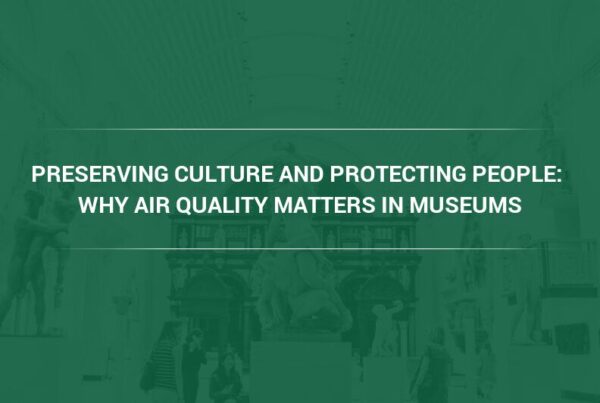Menopause marks a significant transition in a woman’s life, bringing with it a host of physical and emotional changes in addition to increasing risk for injuries and diseases. While many factors can influence the onset and severity of menopausal symptoms, a 2024 study published in the journal Science of Total Environment found that long-term air pollution exposure may affect hormone levels during menopause, potentially leading to increased severity of symptoms such as hot flashes and sleep difficulties.
In this article, air quality experts from Camfil explain the findings and implications of the study and provide insights about how women can protect themselves from the potential negative effects of air pollution during this important life stage.
A Brief Explanation of the Menopausal Transition
Menopause is defined as the natural biological process marking the end of a woman’s menstrual cycles and reproductive years, typically occurring between the ages of 45 and 55. Menopause is officially reached after 12 months without a menstrual period.
The menopausal transition, commonly referred to as perimenopause, typically begins several years before full menopause is reached and is characterized by decreases in the production of estrogen and progesterone. This phase can last between four to ten years, during which women may experience a range of symptoms, including irregular menstrual cycles, mood swings, and changes in metabolic rate. As estrogen levels decline, many women also report experiencing hot flashes, night sweats, sleep disturbances, and cognitive changes. With the decrease in estrogen, women may also become more susceptible to certain health conditions, such as osteoporosis (low bone density) and heart disease.
Study: Air Pollution Linked to Sharper Decline in Hormone Levels During Menopause
The study, which was published in Science of Total Environment in 2024, used data from the Study of Women’s Health Across the Nation (SWAN), a larger longitudinal study with over 3000 participants that aims to attain a better understanding of the menopausal transition and other physical and psychological factors affecting women in middle and late adulthood.
1365 women from six different locations across the United States (southeast Michigan; Chicago, IL; Oakland, CA; Los Angeles, CA; Newark, NJ; and Pittsburgh, PA) were included in the air pollution study.
The team of researchers from the University of Michigan analyzed hormone levels of the participants before, during, and after menopause, along with air pollution data based on residence zip code with measurements beginning in 1999. The study found that exposure to fine particulate matter (PM2.5) and nitrogen dioxide (NO2) was associated with an additional decrease in estrogen during perimenopause (leading to lower average hormone levels by the time full menopause was reached) and with a sharper decline in hormone levels over the course of perimenopause (meaning that hormone levels plummeted faster for women with greater air pollution exposure).
Low levels of estrogen often lead to more severe symptoms of menopause, such as hot flashes, difficulties with sleeping, changes in cognitive ability, and mood swings.
Most of the existing scientific literature on the impact of air quality on reproductive health focuses on women of reproductive age and is often limited to women undergoing in-vitro fertilization (IVF); the findings of this study add important insight into the pervasive nature of the effects of air pollution across the lifespan and provide future directions for research.
Combating Air Pollution Exposure by Improving Indoor Air Quality
Americans spend at least 90% of their time indoors on average, and indoor air pollutants can be as much as fifty times more concentrated than pollutants in the outdoor air in the same area. Long- and short-term exposure to air pollution have both been linked to a wide range of health conditions, affecting the heart, lungs, brain, immune system, and other essential functions.
While efforts to reduce air pollution from vehicles and industrial processes are important, reducing indoor air pollution is another critical piece of the puzzle when it comes to reducing the negative impact of air pollution on human health.
Here are some practical steps you can take to limit exposure to air pollution:
- Monitor air quality: Utilize apps and websites to monitor daily air quality in your area. Refrain from outdoor activities, especially high-intensity exercise, on days with high pollution levels.
- Maintain adequate ventilation. Good ventilation requires circulating fresh air and removing stale, polluted indoor air, which can be achieved by using exhaust fans, or opening windows., This is especially important in areas such as kitchens, bathrooms, workshops, and other areas where pollution is generated and is prone to accumulating at high concentrations.
- Replace existing air filters with those carrying a higher MERV rating: High-efficiency air filters tailored to the home’s HVAC system can effectively remove pollutants, allergens, and harmful particles from the indoor environment.
- Maintain HVAC systems: Regular maintenance and cleaning of the HVAC system prevent dust, mold, and pollutant buildup. Using high-efficiency air filters keeps ductwork and air grilles clean. Adhering to the manufacturer’s maintenance guidelines ensures clean air circulation in your home and reduces the risk of respiratory problems.
To determine the best air filtration strategies and solutions for your residential, commercial, or industrial building, contact your local Camfil representative.
About Camfil Clean Air Solutions
For more than half a century, Camfil has been helping people breathe cleaner air. As a leading manufacturer of premium clean air solutions, we provide commercial and industrial systems for air filtration and air pollution control that improve worker and equipment productivity, minimize energy use, and benefit human health and the environment. We firmly believe that the best solutions for our customers are the best solutions for our planet, too. That’s why every step of the way – from design to delivery and across the product life cycle – we consider the impact of what we do on people and the world around us. Through a fresh approach to problem-solving, innovative design, precise process control, and a strong customer focus we aim to conserve more, use less, and find better ways – so we can all breathe easier.
The Camfil Group is headquartered in Stockholm, Sweden, and has 30 manufacturing sites, six R&D centers, local sales offices in 35+ countries, and about 5,600 employees and growing. We proudly serve and support customers in a wide variety of industries and communities across the world. To discover how Camfil USA can help you to protect people, processes, and the environment, visit us at www.camfil.us/
##
Media Contact:
Lynne Laake
Camfil USA Air Filters
T: 888.599.6620
E: Lynne.Laake@camfil.com
F: Friend Camfil USA on Facebook
T: Follow Camfil USA on Twitter
Y: Watch Camfil Videos on YouTube
L: Follow our LinkedIn Page
Source:
https://www.sciencedirect.com/science/article/abs/pii/S0048969723069450



